Petrology of Peridotites and Nd-Sr Isotopic Composition of Their Clinopyroxenes from the Middle Andaman Ophiolite, India
Abstract
1. Introduction
2. Middle Andaman Peridotites: Geological Background, Samples and Their Petrography
3. Analytical Methods
4. Results
4.1. Major and Trace Element Compositions of Minerals
4.2. Sr and Nd Isotopic Compositions of Clinopyroxene
5. Discussion
5.1. Petrogenesis of Lherzolites in the Mantle Section of the Middle Andaman Ophiolite
5.2. Dunite Petrogenesis and Its Implication for Tectonic Evolution
5.3. Comparison with Other Tethyan Ophiolites
6. Conclusions
Author Contributions
Funding
Acknowledgments
Conflicts of Interest
References
- Dilek, Y.; Furnes, H. Ophiolite genesis and global tectonics: Geochemical and tectonic fingerprinting of ancient oceanic Lithosphere. Geol. Soc. Am. Bull. 2011, 123, 387–411. [Google Scholar] [CrossRef]
- Metcalfe, I. Gondwana dispersion and Asian accretion: Tectonic and palaeogeographic evolution of eastern Tethys. J. Asian Earth Sci. 2013, 66, 1–33. [Google Scholar] [CrossRef]
- Liu, C.-Z.; Zhan, C.; Xu, Y.; Wang, J.-G.; Chen, Y.; Guo, S.; Wu, F.-Y.; Sein, K. Petrology and geochemistry of mantle peridotites from the Kalaymyo and Myitkyina ophiolites (Myanmar): Implications for tectonic settings. Lithos 2016, 264, 495–508. [Google Scholar] [CrossRef]
- Ghosh, B.; Mukhopadhyay, S.; Morishita, T.; Tamura, A.; Arai, S.; Bandyopadhyay, D.; Chattopadhaya, S.; Ovung, T.N. Diversity and evolution of suboceanic mantle: Constraints from Neotethyan ophiolites at the eastern margin of the Indian plate. J. Asian Earth Sci. 2018, 160, 67–77. [Google Scholar] [CrossRef]
- Boudier, F.; Nicolas, A. Harzburgite and lherzolite subtypes in ophiolitic and oceanic environments. Earth Planet. Sci. Lett. 1985, 76, 84–92. [Google Scholar] [CrossRef]
- Picazo, S.; Müntener, O.; Manatschal, G.; Bauville, A.; Karner, G.; Johnson, C. Mapping the nature of mantle domains in Western and Central Europe based on clinopyroxene and spinel chemistry: Evidence for mantle modification during an extensional cycle. Lithos 2016, 266–267, 233–263. [Google Scholar] [CrossRef]
- Morishita, T.; Dilek, Y.; Shallo, M.; Tamura, A.; Arai, S. Insight into the uppermost mantle section of a maturing arc: The Eastern Mirdita ophiolite, Albania. Lithos 2011, 124, 215–226. [Google Scholar] [CrossRef]
- Ghosh, B.; Pal, T.; Bhattacharya, A.; Das, D. Petrogenetic implications of ophiolitic chromite from Rutland Island, Andaman-a boninitic parentage in supra-subduction setting. Mineral. Petrol. 2009, 96, 59–70. [Google Scholar] [CrossRef]
- Ghosh, B.; Morishita, T.; Bhatta, K. Significance of chromian spinels from the mantle sequence of the Andaman Ophiolite, India: Paleogeodynamic implications. Lithos 2013, 164–167, 86–96. [Google Scholar] [CrossRef]
- Pal, T. Petrology and geochemistry of the Andaman ophiolite: Melt-rock interaction in a suprasubduction-zone setting. J. Geol. Soc. Lond. 2011, 168, 1031–1045. [Google Scholar] [CrossRef]
- Ghosh, B.; Morishita, T.; Bhatta, K. Detrital chromian spinels from beach placers of Andaman Islands, India: A perspective view of petrological characteristics and variations of the Andaman ophiolite. Isl. ARC 2012, 21, 188–201. [Google Scholar] [CrossRef]
- Ghosh, B.; Bandyopadhyay, D.; Morishita, T. Andaman–Nicobar Ophiolites, India: Origin, evolution and emplacement. Geol. Soc. Lond. Mem. 2017, 47, 95–110. [Google Scholar] [CrossRef]
- Curray, J.R. Tectonics and history of the Andaman Sea region. J. Asian Earth Sci. 2005, 25, 187–228. [Google Scholar] [CrossRef]
- Pedersen, R.B.; Searle, M.P.; Carter, A.; Bandopadhyay, P.C. U-Pb zircon age of the Andaman ophiolite: Implications for the beginning of subduction beneath the Andaman–Sumatra arc. J. Geol. Soc. Lond. 2010, 167, 1105–1112. [Google Scholar] [CrossRef]
- Sarma, D.S.; Jafri, S.H.; Fletcher, I.R.; McNaughton, N.J. Constraints on the tectonic setting of the Andaman ophiolites, Bay of Bengal, India, from SHRIMP U-Pb zircon geochronology of plagiogranite. J. Geol. 2010, 118, 691–697. [Google Scholar] [CrossRef]
- Singh, A.K.; Chung, S.-L.; Bikramaditya, R.K.; Lee, H.Y. New U-Pb zircon ages of plagiogranites from the Nagaland-Manipur Ophiolites, Indo-Myanmar Orogenic Belt, NE India. J. Geol. Soc. Lond. 2016, 174, 170–191. [Google Scholar] [CrossRef]
- Jafri, S.H.; Charan, S.N.; Govil, P.K. Plagiogranite from the Andaman ophiolite belt, Bay of Bengal, India. J. Geol. Soc. Lond. 1995, 152, 681–687. [Google Scholar] [CrossRef]
- Snow, J.E.; Hart, S.R.; Dick, H.J.B. Orphan Sr-87 in abyssal peridotites—Daddy was a granite. Science 1993, 262, 1861–1863. [Google Scholar] [CrossRef] [PubMed]
- Yoshikawa, M.; Nakamura, E.; Takahashi, E. Rb-Sr isotope systematics in a phlogopite-bearing spinel lherzolite and its implications for age and origin of metasomatism in the Horoman peridotite complex, Hokkaido, Japan. J. Min. Petrol. Econ. Geol. 1993, 88, 121–130. [Google Scholar] [CrossRef][Green Version]
- Shibata, T.; Yoshikawa, M. Precise isotope determination of trace amounts of Nd in ultramafic rock samples. J. Mass Spec. Soc. Jpn. 2004, 52, 317–324. [Google Scholar] [CrossRef]
- Takahashi, E.; Uto, K.; Schilling, J.G. Primary Magma Compositions and Mg/Fe Ratios of their Mantle Residues along Mid Atlantic Ridges 29° N to 73° N. In Technical Report of ISEI; Okayama University: Okayama, Japan, 1987; A-9; pp. 1–12. [Google Scholar]
- Arai, S. An estimation of the least depleted spinel peridotite on the basis of olivine-spinel mantle array. Neues Jahrb. Mineral.-Mon. 1987, 8, 347–354. [Google Scholar]
- Arai, S. Characterization of spinel peridotites by olivine-spinel compositional relationships: Review and interpretation. Chem. Geol. 1994, 113, 191–204. [Google Scholar] [CrossRef]
- Warren, J.M. Global variations in abyssal peridotite compositions. Lithos 2016, 248–251, 193–219. [Google Scholar] [CrossRef]
- Morishita, T.; Nakamura, K.; Shibuya, T.; Kumagai, H.; Sato, T.; Okino, K.; Sato, H.; Nauchi, R.; Hara, K.; Takamaru, R. Petrology of peridotites and related gabbroic rocks around the Kairei Hydrothermal Field in the Central Indian Ridge. In Subseafloor Biosphere Linked to Hydrothermal Systems: TAIGA Concept; Ishibashi, J.-I., Ed.; Springer: Tokyo Heidelberg New York Dordrecht London, 2015; Available online: https://link.springer.com/chapter/10.1007/978-4-431-54865-2_14 (accessed on 17 September 2018).
- McDonough, W.F.; Sun, S.-S. The composition of the Earth. Chem. Geol. 1995, 120, 223–253. [Google Scholar] [CrossRef]
- Warren, J.M.; Shimizu, N.; Sakaguchi, C.; Dick, H.J.B.; Nakamura, E. An assessment of upper mantle heterogeneity based on abyssal peridotite isotopic compositions. J. Geophys. Res. 2009, 114, B12203. [Google Scholar] [CrossRef]
- Cipriani, A.; Brueckener, H.K.; Bonatti, E.; Brunelli, D. Oceanic crust generated by elusive parents: Sr and Nd isotopes in basalt-peridotite pairs from the Mid-Atlantic Ridge. Geology 2004, 32, 657–660. [Google Scholar] [CrossRef]
- Su, Y.; Langmuir, C.H. Global MORB Chemistry Compilation at the Segment Scale. Ph.D. Thesis, Department of Earth and Environmental Science, Columbia University, New York, NY, USA, 2003. [Google Scholar]
- Workman, R.K.; Hart, S.R. Major and trace element compositions of the depleted MORB mantle (DMM). Earth Planet. Sci. Lett. 2005, 231, 53–72. [Google Scholar] [CrossRef]
- Kinzler, R.J.; Grove, T.L. Primary magmas of mid-ocean ridge basalts 1. Experiments and Methods. J. Geophys. Res. 1992, 97, 6885–6906. [Google Scholar] [CrossRef]
- Ozawa, K. Mass balance equations for open magmatic systems: Trace element behavior and its application to open system melting in the upper mantle. J. Geophys. Res. 2001, 106, 13407–13434. [Google Scholar] [CrossRef]
- Ozawa, K.; Shimizu, N. Open-system melting in the upper mantle: Constraints from the Hayachine-Miyamori ophiolite, northeastern Japan. J. Geophys. Res. 1995, 100, 22315–22335. [Google Scholar] [CrossRef]
- Kelemen, P.B. Reaction between ultramafic rocks and fractionating basaltic magma I. Phase relations, the origin of calc-alkaline magma series, and the formation of discordant dunite. J. Petrol. 1990, 31, 51–98. [Google Scholar] [CrossRef]
- Kelemen, P.B.; Shimizu, N.; Salters, V.J.M. Extraction of mid-ocean-ridge basalt from the upwelling mantle by focused flow of melt in dunite channels. Nature 1995, 375, 747–753. [Google Scholar] [CrossRef]
- Morishita, T.; Maeda, J.; Miyashita, S.; Kumagai, H.; Matsumoto, T.; Dick, H.J.B. Petrology of local concentrateon of Chromian spinel in dunite from the slow-spreading Southwest Indian Ridge. Eur. J. Mineral. 2007, 19, 871–882. [Google Scholar] [CrossRef]
- Payot, B.D.; Arai, S.; Dick, H.J.B.; Abe, N.; Ichiyama, Y. Podiform chromitite formation in a low-Cr/high-Al system: An example from the Southwest Indian Ridge (SWIR). Mineral. Petrol. 2014, 108, 533–549. [Google Scholar] [CrossRef]
- Müntener, O.; Pettke, T.; Desmurs, L.; Meier, M.; Schaltegger, U. Refertilization of mantle peridotite in embryonic ocean basins: Trace element and Nd isotopic evidence and implications for crust-mantle relationships. Earth Planet. Sci. Lett. 2004, 221, 293–308. [Google Scholar] [CrossRef]
- Rampone, E.; Hofmann, A.W.; Piccardo, G.B.; Vannucci, R.; Bottazzi, P.; Ottolini, L. Petrology, mineral and isotope geochemistry of the External Liguride Peridotites (Northern Apennines, Italy). J. Petrol. 1995, 36, 81–105. [Google Scholar] [CrossRef]
- Rampone, E.; Hofmann, A.W.; Piccardo, G.B.; Vannucci, R.; Bottazzi, P.; Ottolini, L. Trace element and isotope geochemistry of depleted peridotites from an N-MORB type ophiolite (Internal Liguride, N. Italy). Contrib. Mineral. Petrol. 1996, 123, 61–76. [Google Scholar] [CrossRef]
- Rampone, E.; Hofmann, A.W.; Raczek, I. Isotopic equilibrium between mantle peridotite and melt: Evidence from the Corsica ophiolite. Earth Planet. Sci. Lett. 2009, 288, 601–610. [Google Scholar] [CrossRef]
- Tribuzio, R.; Thirlwall, M.F.; Vannucci, R. Origin of gabbro-peridotite association from the Northern Apennine Ophiolites (Italy). J. Petrol. 2004, 45, 1109–1124. [Google Scholar] [CrossRef]
- Rampone, E.; Romairone, A.; Abouchami, W.; Piccardo, G.B.; Hofmann, A.W. Chronology, petrology and isotope geochemistry of the Erro-Tobbio peridotites (Ligurian Alps, Italy): Records of late Palaeozoic lithospheric extension. J. Petrol. 2005, 46, 799–827. [Google Scholar] [CrossRef]
- DePaolo, D.J. Neodymium isotopes in the Colorado Front Range and crust-mantle evolution in the Proterozoic. Nature 1981, 291, 193–196. [Google Scholar] [CrossRef]
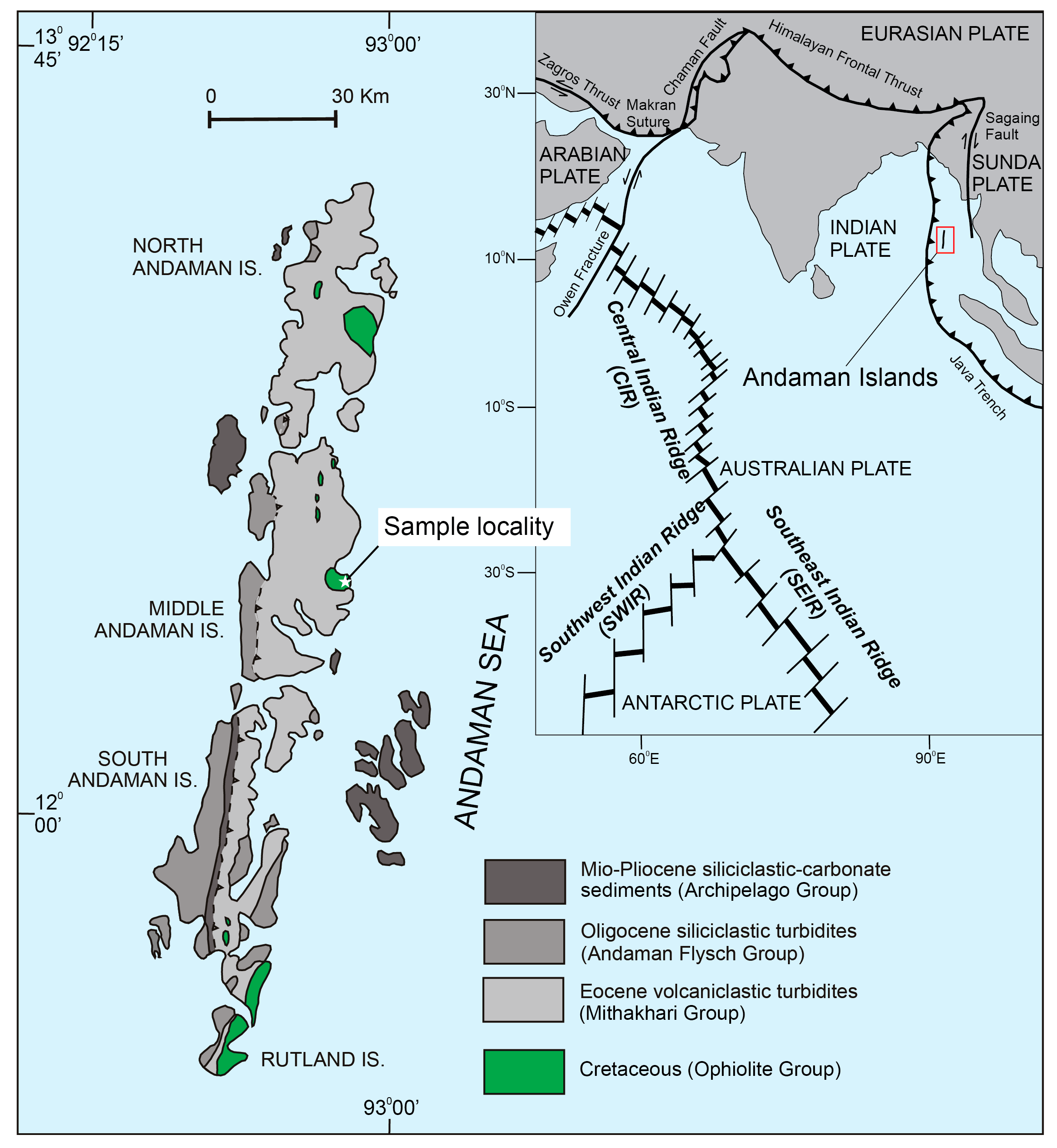
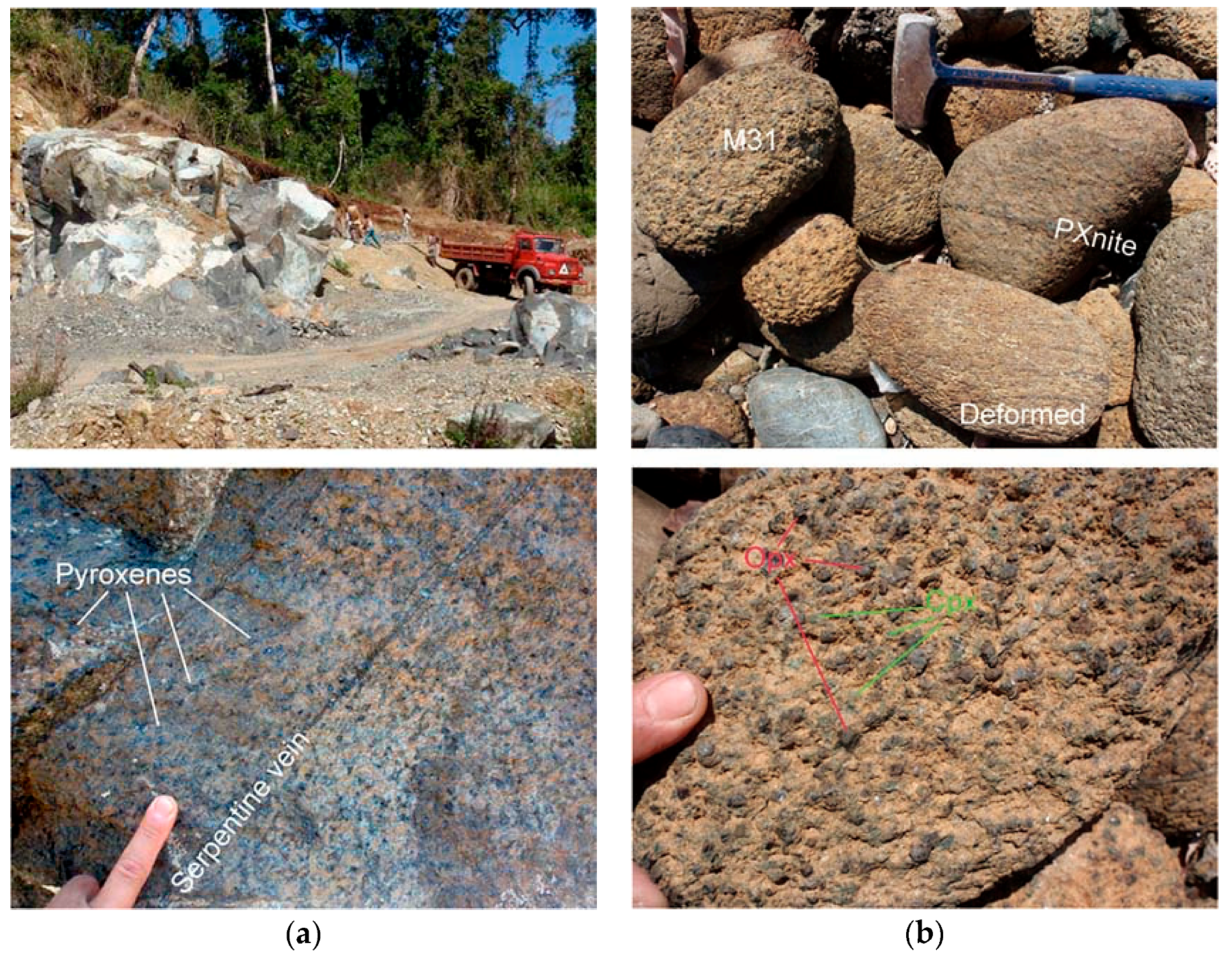
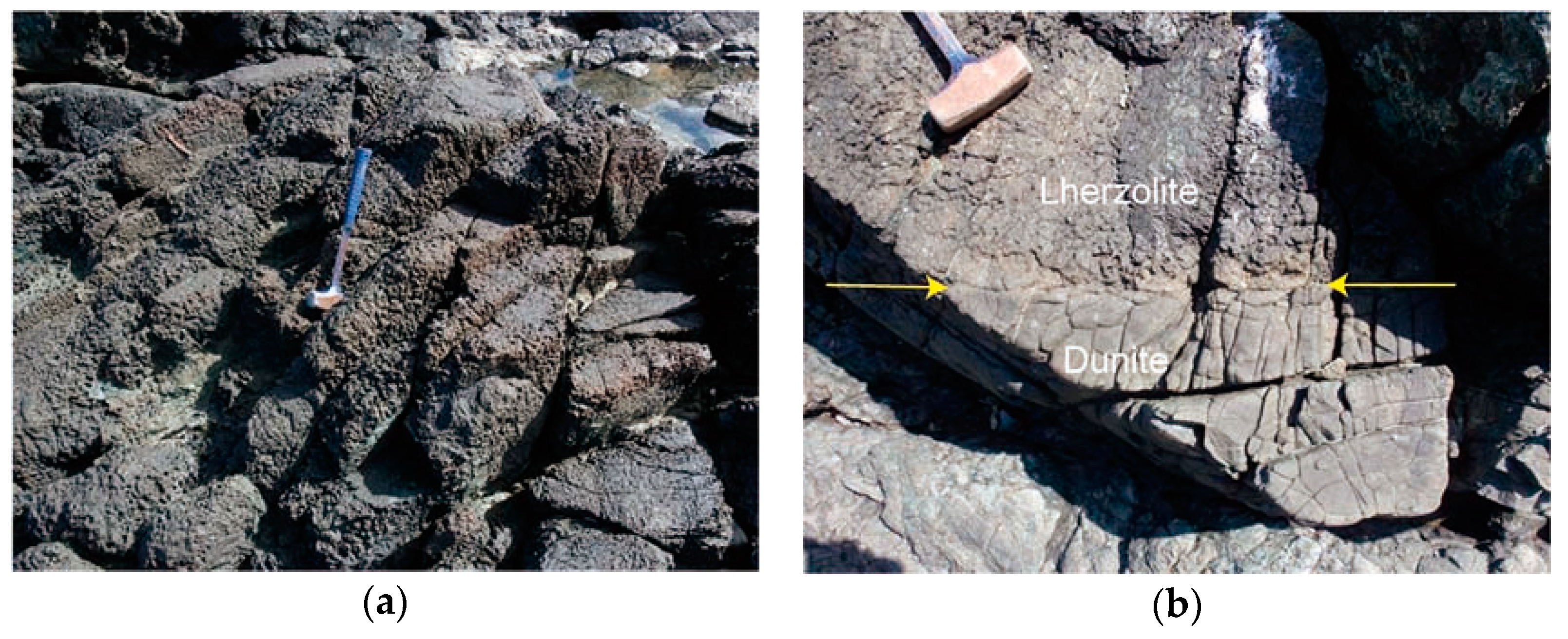

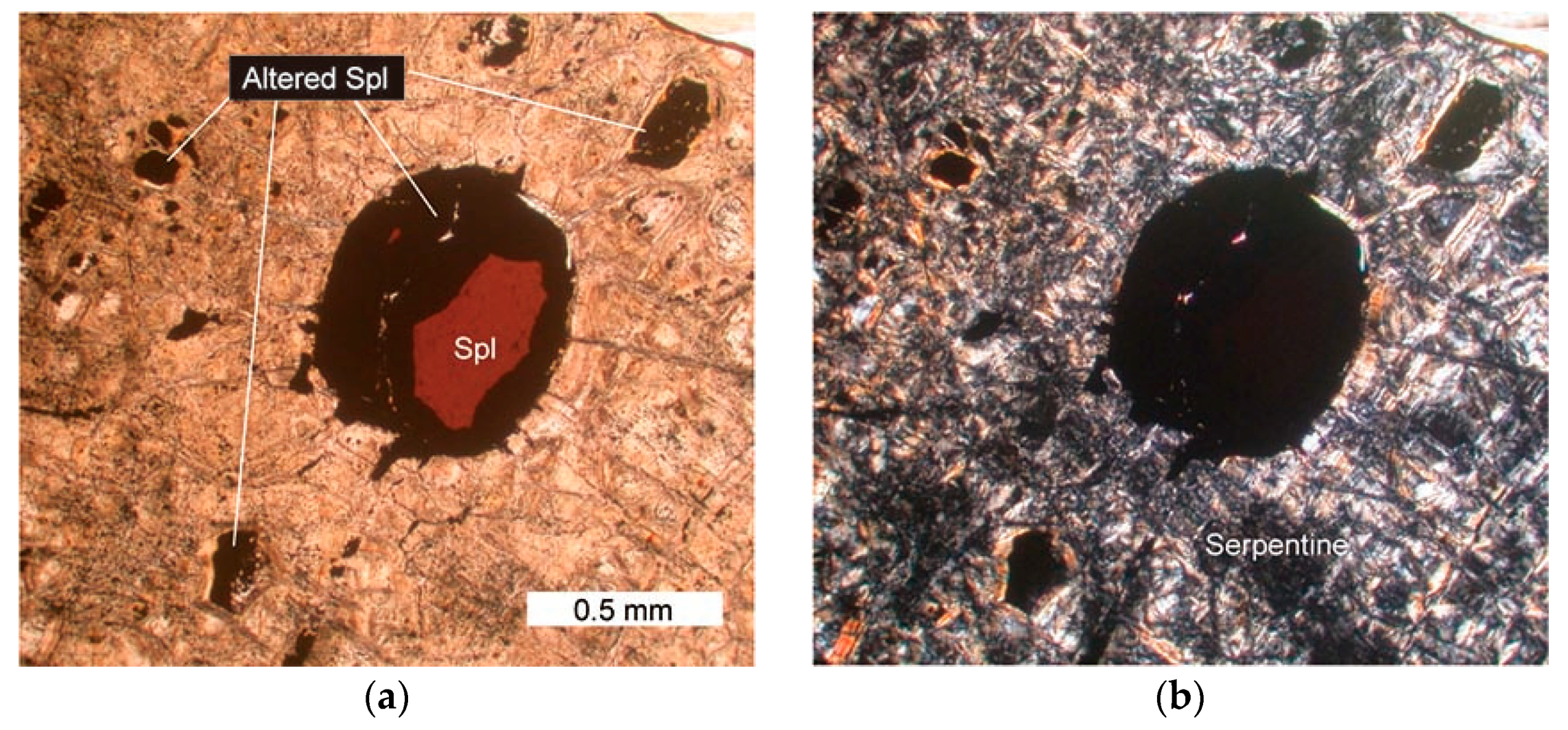
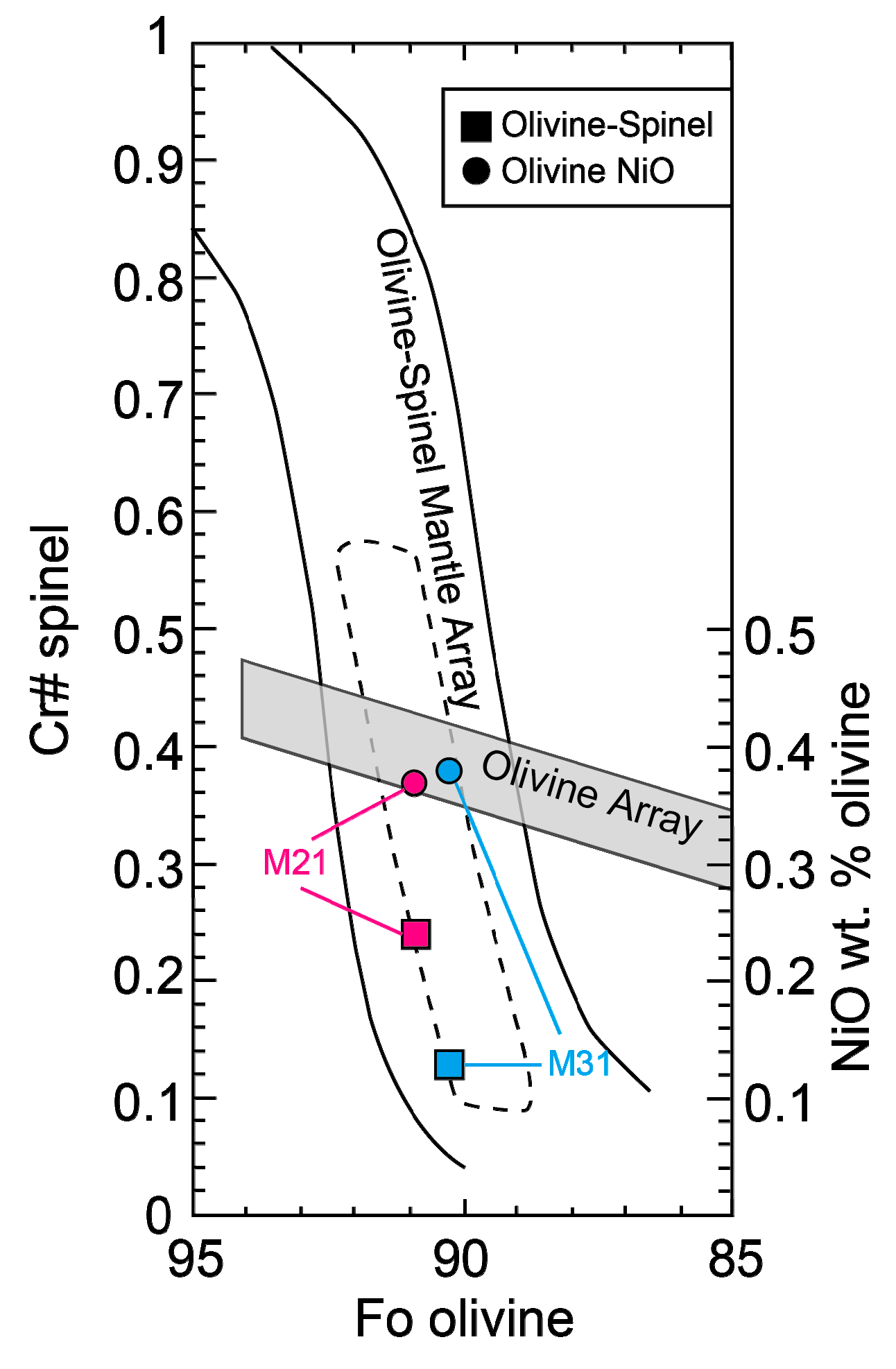

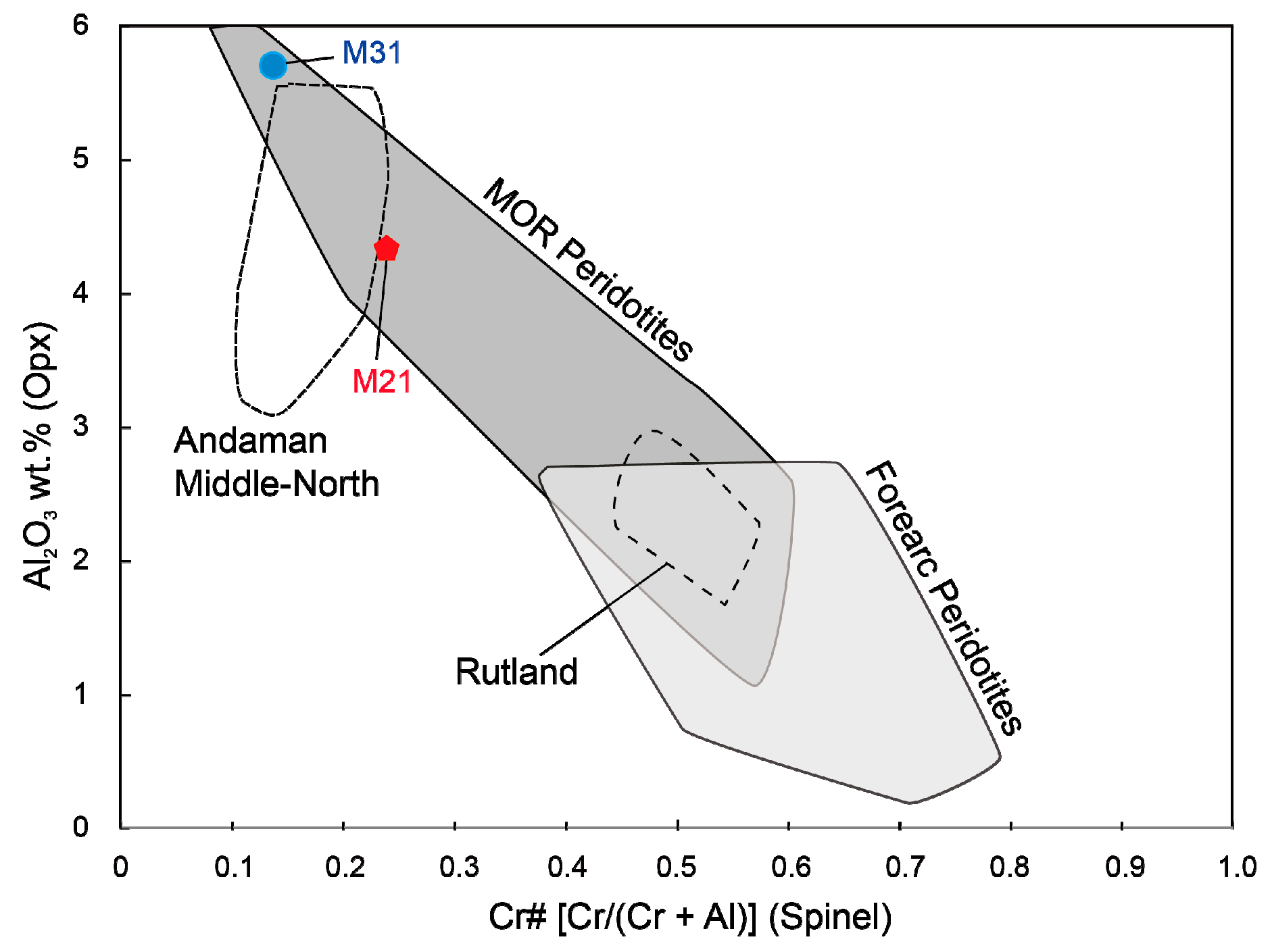
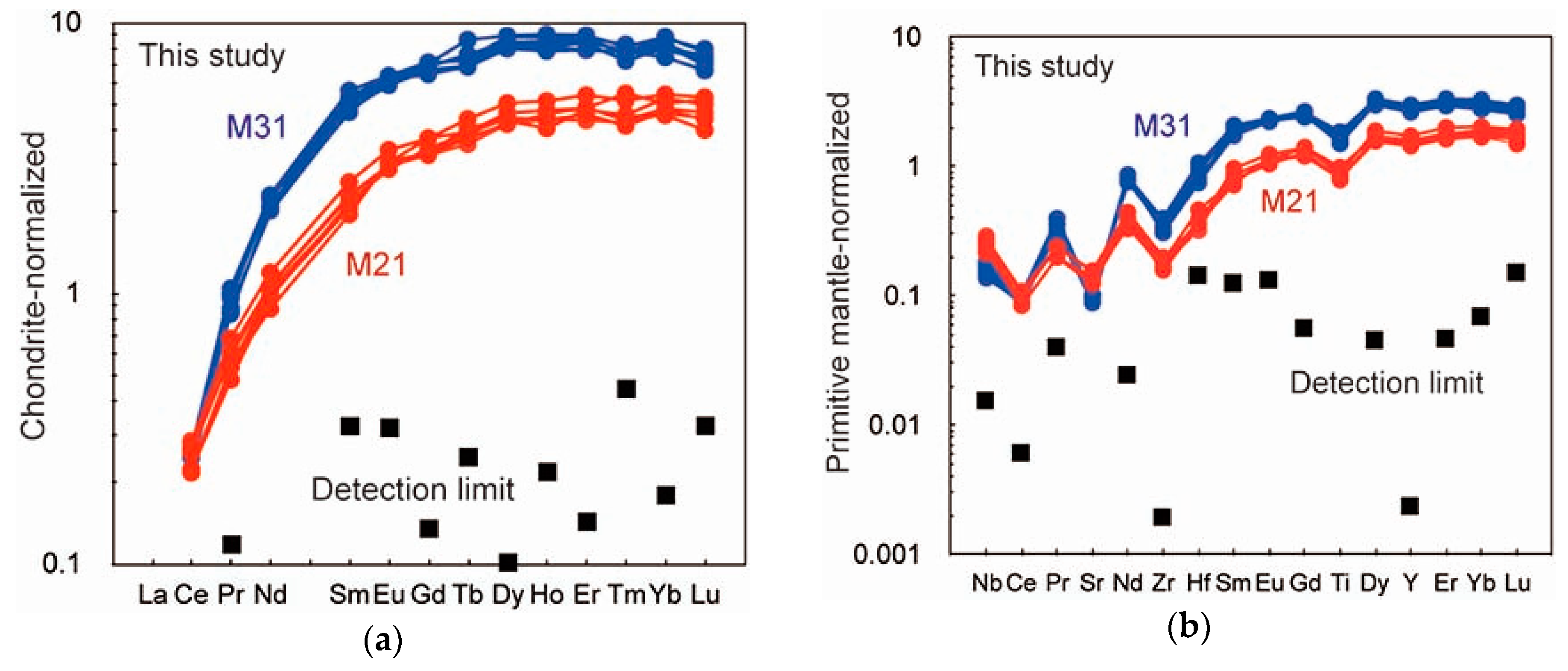
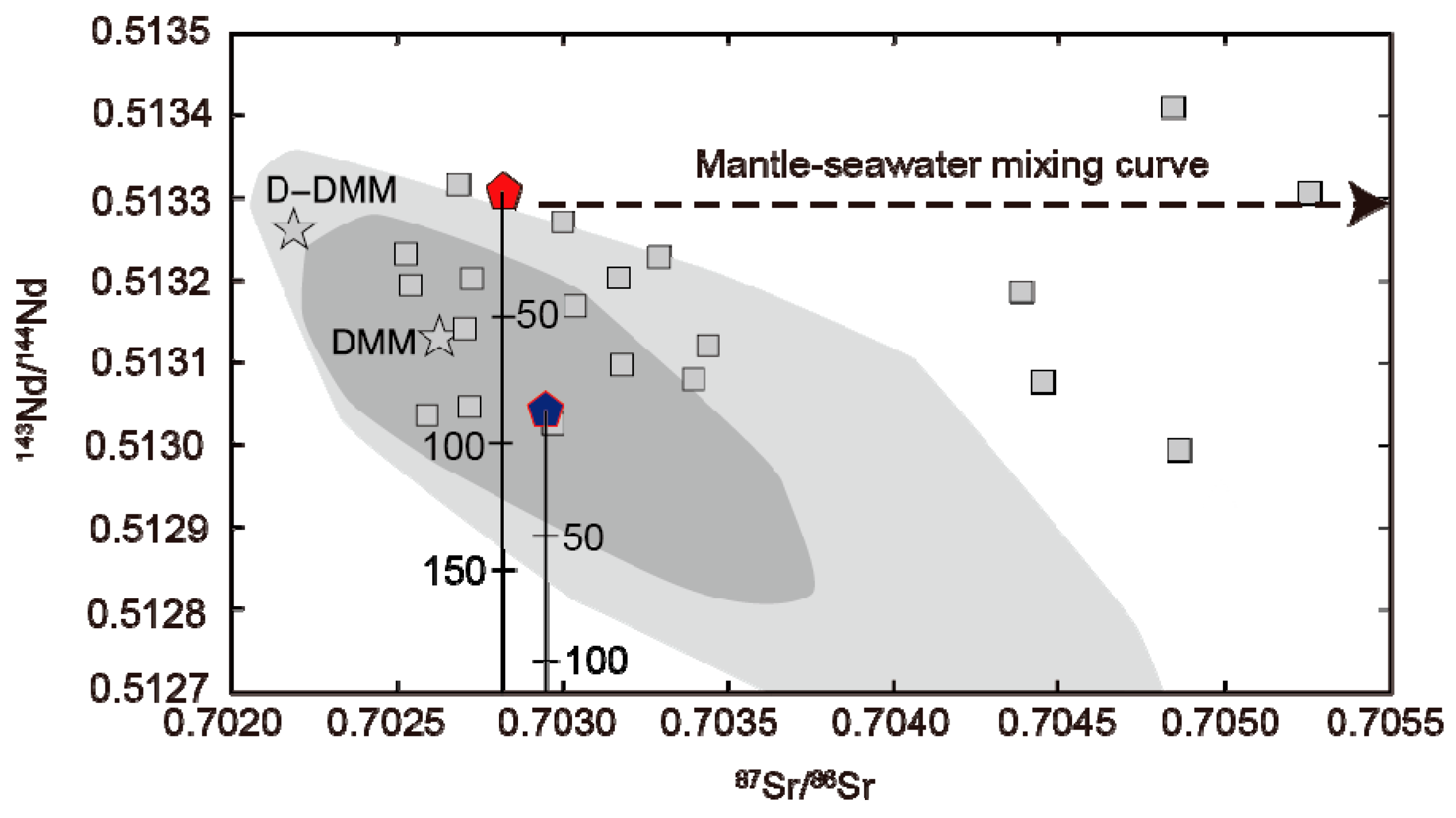
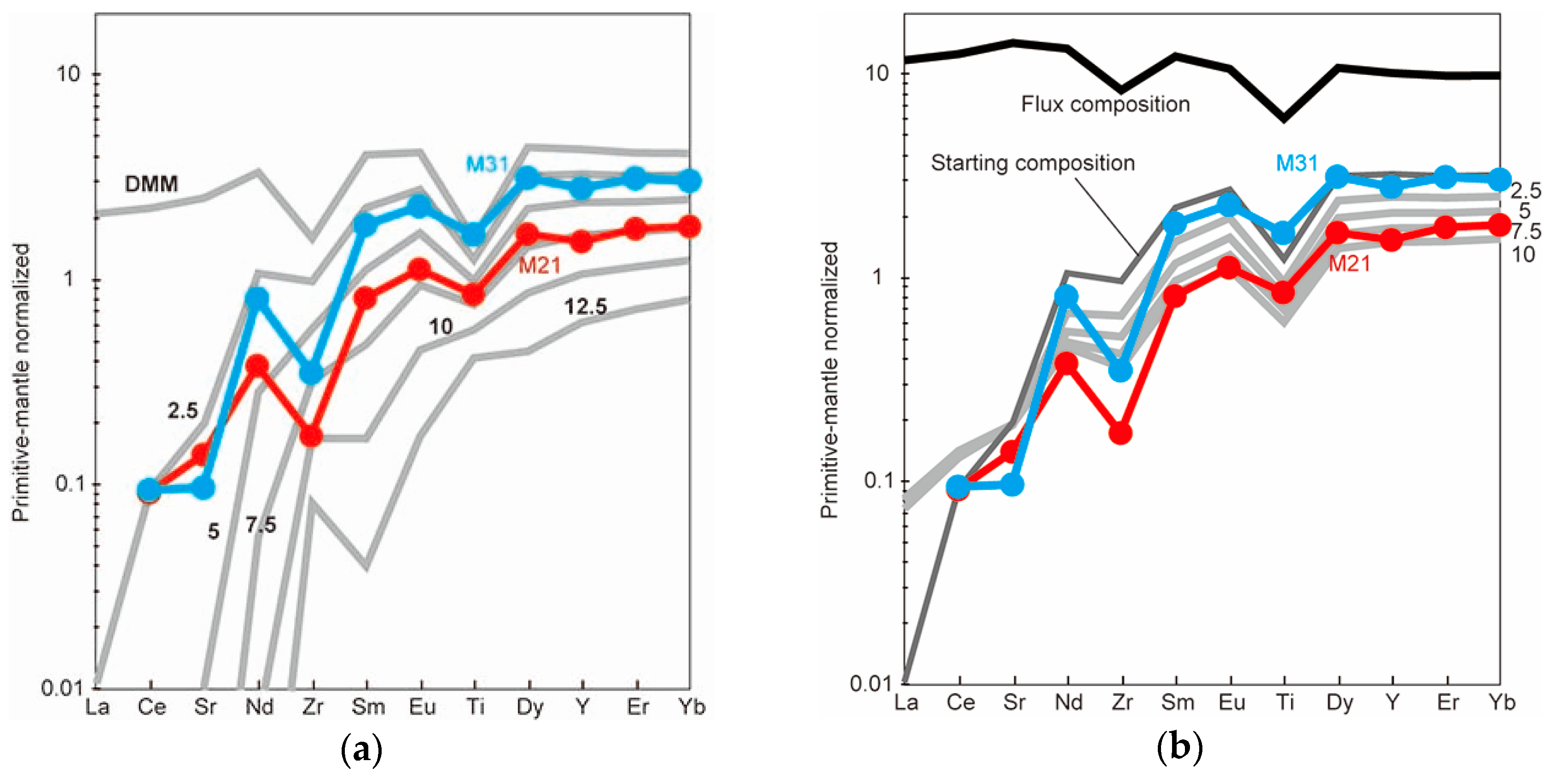
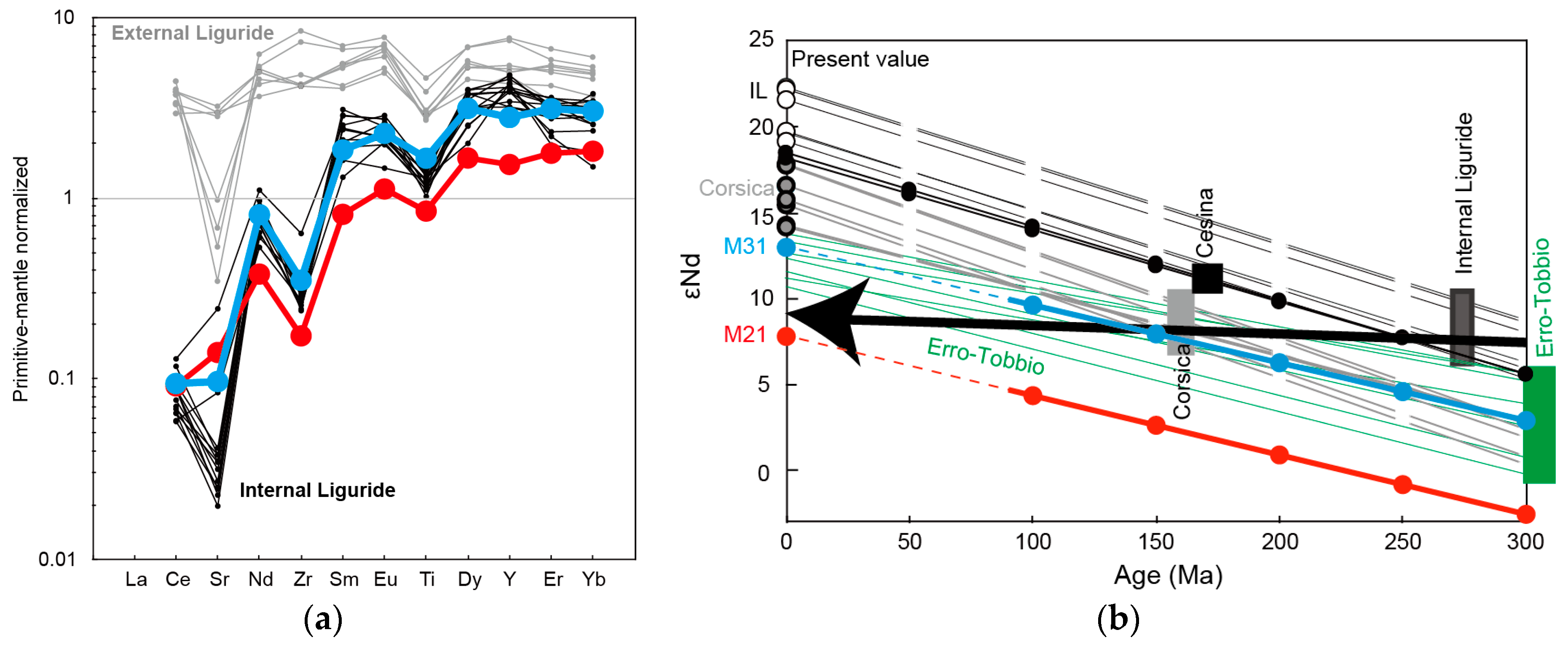
| Sample | M21 | |||||
| Mineral | Olivine Average | STD (N = 7) | OPX-3-core | OPX-3-rim | OPX-10-core | OPX-10-rim |
| SiO2 | 41.2 | 0.18 | 55.1 | 57.5 | 55.6 | 56.5 |
| TiO2 | <0.04 | <0.04 | <0.04 | <0.04 | <0.04 | |
| Al2O3 | <0.03 | 4.5 | 2.2 | 4.0 | 3.6 | |
| Cr2O3 | <0.05 | 0.74 | 0.40 | 0.73 | 0.57 | |
| FeO | 8.9 | 0.16 | 5.8 | 5.6 | 5.8 | 5.7 |
| MnO | 0.13 | 0.05 | 0.19 | 0.13 | 0.14 | 0.14 |
| MgO | 50.3 | 0.17 | 32.9 | 35.2 | 33.5 | 34.1 |
| CaO | 0.03 | 0.02 | 0.75 | 0.43 | 0.62 | 0.70 |
| Na2O | <0.03 | <0.03 | <0.03 | <0.03 | <0.03 | |
| K2O | <0.03 | <0.03 | <0.03 | <0.03 | <0.03 | |
| NiO | 0.37 | 0.02 | 0.08 | 0.08 | <0.08 | 0.14 |
| total | 100.9 | 0.3 | 100.1 | 101.6 | 100.5 | 101.4 |
| XMg | 0.909 | 0.152 | 0.910 | 0.918 | 0.911 | 0.915 |
| XCr | 0.100 | 0.107 | 0.108 | 0.095 | ||
| Sample | M31 | |||||
| Mineral | Olivine Average | STD (N = 8) | OPX-6-core | OPX-6-rim | OPX-3-core | OPX-3-core |
| SiO2 | 41.1 | 0.19 | 53.8 | 55.1 | 54.3 | 55.4 |
| TiO2 | <0.04 | 0.12 | 0.10 | 0.10 | 0.07 | |
| Al2O3 | <0.03 | 5.7 | 4.6 | 5.1 | 3.8 | |
| Cr2O3 | <0.05 | 0.70 | 0.50 | 0.52 | 0.30 | |
| FeO | 9.6 | 0.14 | 6.1 | 6.4 | 5.9 | 6.3 |
| MnO | 0.14 | 0.03 | 0.12 | 0.19 | 0.19 | 0.13 |
| MgO | 49.7 | 0.22 | 32.5 | 32.8 | 32.5 | 33.4 |
| CaO | 0.03 | 0.02 | 0.64 | 0.67 | 0.76 | 0.63 |
| Na2O | <0.03 | 0.07 | 0.06 | <0.03 | <0.03 | |
| K2O | <0.03 | <0.03 | <0.03 | <0.03 | <0.03 | |
| NiO | 0.38 | 0.04 | 0.08 | 0.10 | 0.14 | <0.08 |
| total | 101.1 | 0.4 | 99.9 | 100.5 | 99.5 | 100.1 |
| XMg | 0.902 | 0.001 | 0.904 | 0.902 | 0.907 | 0.905 |
| XCr | 0.076 | 0.068 | 0.064 | 0.050 |
| Sample | M21 | M31 | M42DH | |||
|---|---|---|---|---|---|---|
| Average | STD (N = 7) | Average | STD (N = 15) | Average | STD (N = 5) | |
| wt.% | ||||||
| TiO2 | 0.05 | 0.03 | <0.04 | 0.12 | 0.02 | |
| Al2O3 | 45.7 | 0.9 | 55.9 | 0.8 | 47.0 | 0.5 |
| Cr2O3 | 21.9 | 1.3 | 11.6 | 0.7 | 20.2 | 0.6 |
| Fe2O3 | 1.8 | 0.3 | 1.5 | 0.4 | 2.3 | 0.3 |
| FeO | 11.9 | 0.3 | 10.1 | 0.3 | 10.8 | 0.2 |
| MnO | 0.17 | 0.05 | 0.12 | 0.03 | 0.16 | 0.03 |
| MgO | 17.7 | 0.2 | 19.9 | 0.2 | 18.6 | 0.2 |
| NiO | 0.22 | 0.02 | 0.34 | 0.04 | 0.28 | 0.05 |
| total | 99.6 | 0.5 | 99.5 | 0.5 | 99.7 | 0.9 |
| XMg | 0.726 | 0.007 | 0.778 | 0.006 | 0.753 | 0.006 |
| XCr | 0.243 | 0.015 | 0.122 | 0.007 | 0.224 | 0.006 |
| YFe3+ | 1.8 | 0.3 | 1.4 | 0.4 | 2.4 | 0.3 |
| YAl | 74.3 | 1.4 | 86.5 | 0.9 | 75.7 | 0.6 |
| YCr | 23.9 | 1.4 | 12.1 | 0.7 | 21.9 | 0.6 |
| Sample | M31 | |||||||
| Occurrence | 4-Core | 4-Rim | 10-fine | 10-fine | 11-fine | 11-fine | 12-fine | 14-Core |
| wt.% | ||||||||
| SiO2 | 51.0 | 51.0 | 51.6 | 52.3 | 51.9 | 52.3 | 51.4 | 51.6 |
| TiO2 | 0.25 | 0.24 | 0.37 | 0.35 | 0.31 | 0.34 | 0.3 | 0.32 |
| Al2O3 | 6.9 | 5.1 | 5.6 | 5.6 | 6.2 | 5.3 | 6.5 | 6.9 |
| Cr2O3 | 1.06 | 0.71 | 0.78 | 0.8 | 0.93 | 0.74 | 0.9 | 1.03 |
| FeO | 2.4 | 2.7 | 2.5 | 2.7 | 2.5 | 2.6 | 2.5 | 2.4 |
| MnO | 0.14 | 0.09 | 0.13 | 0.07 | 0.09 | 0.06 | 0.08 | 0.2 |
| MgO | 14.6 | 16.3 | 15.6 | 15.9 | 15.4 | 15.7 | 14.9 | 14.9 |
| CaO | 21.7 | 20.9 | 21.8 | 21.4 | 21.4 | 21.8 | 21.3 | 21.6 |
| Na2O | 0.95 | 0.7 | 0.92 | 0.88 | 1.01 | 0.86 | 1.07 | 1.05 |
| K2O | <0.03 | <0.03 | <0.03 | <0.03 | <0.03 | <0.03 | <0.03 | <0.03 |
| NiO | <0.08 | <0.08 | <0.08 | <0.08 | <0.08 | <0.08 | <0.08 | <0.08 |
| Total | 99.0 | 97.9 | 99.5 | 100.0 | 99.9 | 99.7 | 99.1 | 99.9 |
| ppm | ||||||||
| Li | 3.52 | 3.27 | 3.1 | 3.52 | 3.68 | 3.74 | 3.85 | 3.68 |
| Ti | 1802 | 2127 | 2105 | 2214 | 2004 | 2000 | 1946 | 1814 |
| Sr | 1.93 | 2 | 1.85 | 1.75 | 1.91 | 2.03 | 1.95 | 1.94 |
| Y | 12.23 | 12.76 | 12.07 | 12.66 | 11.77 | 11.26 | 11.7 | 11.74 |
| Zr | 3.31 | 4.04 | 4.15 | 4.04 | 3.61 | 3.54 | 3.56 | 3.21 |
| Nb | 0.12 | 0.1 | 0.1 | 0.1 | 0.1 | 0.09 | 0.12 | 0.11 |
| La | < | < | < | < | < | < | < | < |
| Ce | 0.16 | 0.17 | 0.14 | 0.16 | 0.16 | 0.15 | 0.16 | 0.16 |
| Pr | 0.09 | 0.10 | 0.08 | 0.08 | 0.09 | 0.08 | 0.10 | 0.09 |
| Nd | 1.04 | 1.03 | 0.94 | 0.97 | 1.04 | 0.95 | 1.07 | 1.05 |
| Sm | 0.72 | 0.77 | 0.72 | 0.76 | 0.79 | 0.70 | 0.84 | 0.70 |
| Eu | 0.35 | 0.36 | 0.34 | 0.35 | 0.36 | 0.35 | 0.36 | 0.34 |
| Gd | 1.39 | 1.42 | 1.34 | 1.41 | 1.39 | 1.30 | 1.44 | 1.35 |
| Tb | 0.28 | 0.32 | 0.25 | 0.27 | 0.28 | 0.25 | 0.26 | 0.25 |
| Dy | 2.12 | 2.23 | 2.10 | 2.20 | 2.10 | 2.00 | 2.12 | 2.05 |
| Ho | 0.47 | 0.50 | 0.47 | 0.49 | 0.45 | 0.44 | 0.46 | 0.45 |
| Er | 1.42 | 1.45 | 1.39 | 1.40 | 1.37 | 1.28 | 1.35 | 1.29 |
| Tm | 0.21 | 0.20 | 0.19 | 0.20 | 0.20 | 0.20 | 0.18 | 0.19 |
| Yb | 1.37 | 1.44 | 1.33 | 1.42 | 1.34 | 1.21 | 1.31 | 1.29 |
| Lu | 0.18 | 0.19 | 0.18 | 0.20 | 0.17 | 0.17 | 0.19 | 0.18 |
| Hf | 0.23 | 0.28 | 0.30 | 0.30 | 0.26 | 0.28 | 0.29 | 0.21 |
| Sample | M21 | |||||||
| Occurence | 1 | 5-fine | 7-Core | 8-fine | 8 | 13-fine | 14-Core | |
| wt.% | ||||||||
| SiO2 | 52.3 | 52.2 | 52.1 | 52.2 | 52.0 | 52.5 | 52.2 | |
| TiO2 | 0.2 | 0.22 | 0.12 | 0.18 | 0.19 | 0.19 | 0.17 | |
| Al2O3 | 5.3 | 5.3 | 5.6 | 4.8 | 4.8 | 5.0 | 5.4 | |
| Cr2O3 | 1.21 | 1.34 | 1.49 | 1.18 | 1.28 | 1.35 | 1.4 | |
| FeO | 2.2 | 2.4 | 2.4 | 2.3 | 2.0 | 2.3 | 2.5 | |
| MnO | 0.07 | 0.1 | 0.12 | 0.15 | 0.1 | 0.09 | 0.1 | |
| MgO | 15.5 | 15.6 | 15.5 | 16.2 | 15.9 | 15.7 | 15.5 | |
| CaO | 21.8 | 21.7 | 21.8 | 21.5 | 21.8 | 22.2 | 22.0 | |
| Na2O | 1 | 1.03 | 1.01 | 0.94 | 0.91 | 0.96 | 0.96 | |
| K2O | <0.03 | <0.03 | <0.03 | <0.03 | <0.03 | <0.03 | <0.03 | |
| NiO | <0.08 | <0.08 | <0.08 | <0.08 | <0.08 | <0.08 | <0.08 | |
| Total | 99.8 | 99.8 | 100.2 | 99.6 | 99.1 | 100.4 | 100.2 | |
| ppm | DL | |||||||
| Li | 2.51 | 2.43 | 2.63 | 2.42 | 2.35 | 2.17 | 2.99 | 0.25 |
| Ti | 972 | 1064 | 940 | 1008 | 972 | 1178 | 1012 | 0.51 |
| Sr | 3.08 | 3.08 | 2.95 | 2.63 | 2.73 | 2.53 | 2.46 | 0.01 |
| Y | 6.17 | 7.37 | 6.53 | 6.35 | 6.53 | 6.8 | 6.44 | 0.01 |
| Zr | 1.87 | 2.06 | 1.75 | 1.72 | 1.72 | 1.92 | 1.65 | 0.02 |
| Nb | 0.18 | 0.17 | 0.19 | 0.14 | 0.16 | 0.18 | 0.15 | 0.01 |
| La | < | < | < | < | < | < | < | 0.01 |
| Ce | 0.18 | 0.17 | 0.16 | 0.14 | 0.14 | 0.14 | 0.14 | 0.01 |
| Pr | 0.06 | 0.06 | 0.06 | 0.05 | 0.05 | 0.05 | 0.05 | 0.01 |
| Nd | 0.50 | 0.55 | 0.49 | 0.41 | 0.45 | 0.47 | 0.45 | 0.03 |
| Sm | 0.35 | 0.39 | 0.34 | 0.29 | 0.32 | 0.31 | 0.31 | 0.05 |
| Eu | 0.17 | 0.19 | 0.17 | 0.18 | 0.16 | 0.17 | 0.17 | 0.02 |
| Gd | 0.65 | 0.75 | 0.67 | 0.66 | 0.69 | 0.76 | 0.66 | 0.03 |
| Tb | 0.13 | 0.16 | 0.14 | 0.15 | 0.14 | 0.14 | 0.14 | 0.01 |
| Dy | 1.05 | 1.26 | 1.16 | 1.08 | 1.11 | 1.15 | 1.05 | 0.03 |
| Ho | 0.24 | 0.28 | 0.26 | 0.23 | 0.24 | 0.26 | 0.25 | 0.01 |
| Er | 0.71 | 0.87 | 0.77 | 0.77 | 0.74 | 0.78 | 0.79 | 0.02 |
| Tm | 0.11 | 0.13 | 0.11 | 0.11 | 0.10 | 0.14 | 0.11 | 0.01 |
| Yb | 0.75 | 0.89 | 0.86 | 0.74 | 0.77 | 0.82 | 0.78 | 0.03 |
| Lu | 0.11 | 0.13 | 0.12 | 0.10 | 0.11 | 0.13 | 0.12 | 0.01 |
| Hf | 0.10 | 0.10 | 0.09 | 0.10 | 0.11 | 0.13 | 0.10 | 0.04 |
| Sample# | 87Sr/86Sr | 2 sigma | 143Nd/144Nd | 2 sigma | Sm ppm | Nd ppm | εNd at Present | εNd at 100 Ma | εNd at 150 Ma |
|---|---|---|---|---|---|---|---|---|---|
| M21 | 0.702941 | 0.000017 | 0.513038 | 0.000043 | 0.4624 | 0.59938 | 7.8 | 4.4 | 2.6 |
| M31 | 0.702817 | 0.000018 | 0.513303 | 0.000020 | 0.8373 | 1.1023 | 13.0 | 9.6 | 7.9 |
© 2018 by the authors. Licensee MDPI, Basel, Switzerland. This article is an open access article distributed under the terms and conditions of the Creative Commons Attribution (CC BY) license (http://creativecommons.org/licenses/by/4.0/).
Share and Cite
Morishita, T.; Yoshikawa, M.; Tamura, A.; Guotana, J.M.; Ghosh, B. Petrology of Peridotites and Nd-Sr Isotopic Composition of Their Clinopyroxenes from the Middle Andaman Ophiolite, India. Minerals 2018, 8, 410. https://doi.org/10.3390/min8090410
Morishita T, Yoshikawa M, Tamura A, Guotana JM, Ghosh B. Petrology of Peridotites and Nd-Sr Isotopic Composition of Their Clinopyroxenes from the Middle Andaman Ophiolite, India. Minerals. 2018; 8(9):410. https://doi.org/10.3390/min8090410
Chicago/Turabian StyleMorishita, Tomoaki, Masako Yoshikawa, Akihiro Tamura, Juan Miguel Guotana, and Biswajit Ghosh. 2018. "Petrology of Peridotites and Nd-Sr Isotopic Composition of Their Clinopyroxenes from the Middle Andaman Ophiolite, India" Minerals 8, no. 9: 410. https://doi.org/10.3390/min8090410
APA StyleMorishita, T., Yoshikawa, M., Tamura, A., Guotana, J. M., & Ghosh, B. (2018). Petrology of Peridotites and Nd-Sr Isotopic Composition of Their Clinopyroxenes from the Middle Andaman Ophiolite, India. Minerals, 8(9), 410. https://doi.org/10.3390/min8090410





